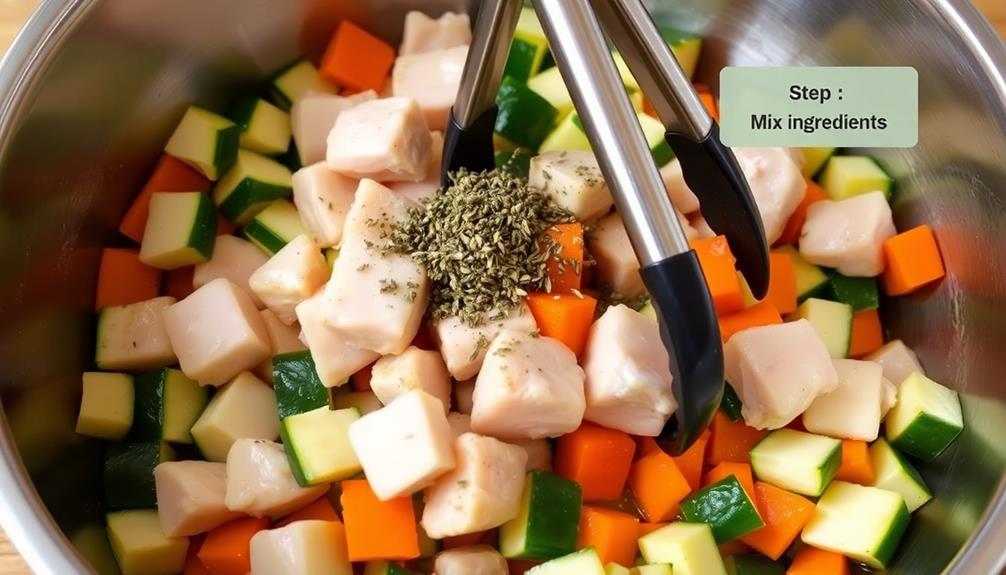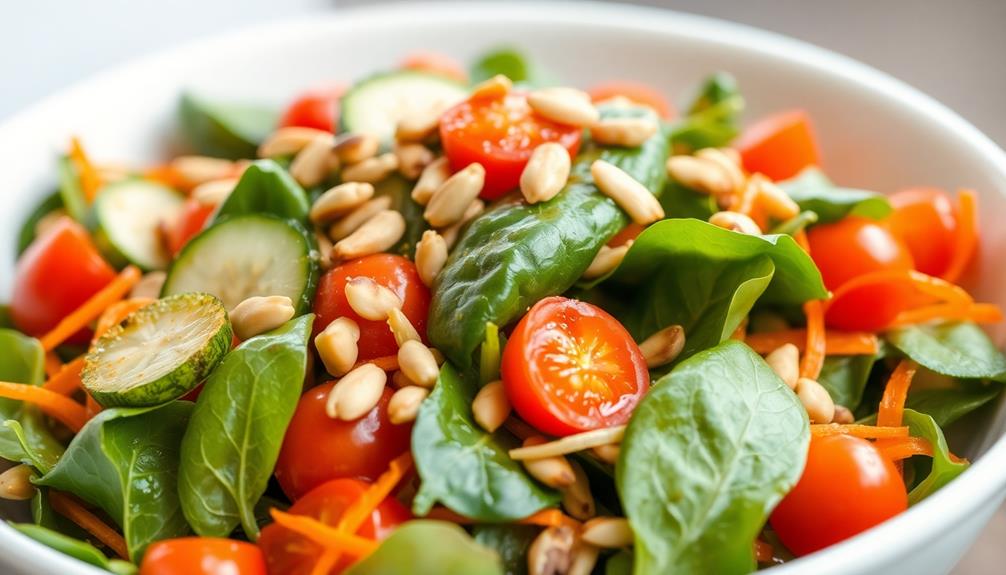When it comes to low-FODMAP meals for kids, the possibilities are endless! You'll find classic dishes like baked chicken and roasted veggies are a hit, with customizable seasonings and healthy fats to fuel little bodies. Staples like rice, potatoes, and kid-friendly fruits and veggies make for versatile, appealing meals. Get the whole family involved in the cooking process – it'll boost their interest in trying new foods. While introducing unfamiliar flavors takes patience, gradual exposure and positive reinforcement can go a long way. From colorful bowls to homemade pizzas, there are so many creative, low-FODMAP options to discover. And that's just the beginning…
Key Takeaways
- Incorporate familiar, low-FODMAP ingredients like rice, potatoes, carrots, and zucchini into appealing dishes to make the diet more child-friendly.
- Involve children in the cooking process to foster interest and encourage them to try new foods.
- Gradually introduce unfamiliar low-FODMAP flavors and textures, as multiple exposures are needed for children to accept them.
- Use versatile staples like chicken and olive oil to create balanced, nutritious meals that can be customized to suit individual preferences.
- Maintain a positive attitude and celebrate small successes to promote a healthy relationship with food, rather than enforcing strict rules.
History
The history of child-friendly low-FODMAP meals dates back to the early 2000s, when researchers first began exploring the potential benefits of this dietary approach for individuals with gastrointestinal issues.
As they delved into the topic, they discovered that certain carbohydrates, known as FODMAPs (Fermentable Oligosaccharides, Disaccharides, Monosaccharides, and Polyols), could trigger uncomfortable symptoms in people with sensitive digestive systems. This led to the development of the low-FODMAP diet, which aims to limit the intake of these problematic carbs.
Over time, the focus shifted to making this diet more accessible and appealing to children. Experts recognized that kids often have different food preferences and may be more reluctant to try unfamiliar dishes.
Recipe
Chicken and vegetables are a classic low-FODMAP meal that's easy to prepare and enjoyed by children. This dish features a selection of roasted vegetables tossed with tender chicken, creating a well-balanced and nourishing meal. The combination of proteins and fiber-rich vegetables makes it an excellent choice for growing kids.
Additionally, incorporating healthy fats like olive oil can enhance the meal's nutritional value, supporting a balanced diet as encouraged by the importance of healthy fats. To ensure this meal is child-friendly, you can customize the vegetable selection to include your child's favorites.
Additionally, you can adjust the seasoning to suit their taste preferences, making it a versatile and appealing option for the whole family.
Ingredients:
- 1 lb boneless, skinless chicken breasts, cut into 1-inch cubes
- 2 cups diced zucchini
- 1 cup diced bell pepper (any color)
- 1 cup diced carrots
- 2 tablespoons olive oil
- 1 teaspoon dried thyme
- 1 teaspoon dried oregano
- Salt and black pepper to taste
Cooking Instructions:
Preheat your oven to 400°F (200°C). In a large mixing bowl, combine the cubed chicken, diced vegetables, olive oil, thyme, oregano, salt, and black pepper. Toss the ingredients until the chicken and vegetables are evenly coated.
Spread the mixture onto a large baking sheet lined with parchment paper. Bake for 25-30 minutes, or until the chicken is cooked through and the vegetables are tender.
Tips:
To make this dish even more appealing to children, you can serve it with a side of low-FODMAP friendly dipping sauce, such as a simple pesto or a yogurt-based dressing.
Additionally, you can encourage your child's involvement by allowing them to help with the vegetable chopping or seasoning the dish. This can help foster their interest in the meal and promote healthy eating habits.
Cooking Steps
First, preheat your oven to 375°F and grease a baking sheet with oil.
Next, thoroughly mix all the ingredients together in a bowl.
Then, bake the dish for 25-30 minutes and let it cool before serving.
Step 1. Preheat Oven to 375°F

Next, preheat your oven to 375°F. This step is crucial for many of the low-FODMAP recipes you'll be making. The higher temperature will help ensure your food cooks evenly and develops a nice golden-brown color.
Once your oven is preheated, you can start preparing the other ingredients. Remember to use oven mitts when handling hot dishes to avoid burns.
If you have a convection oven, you may want to reduce the temperature by 25°F, as convection ovens cook food a bit faster. Keep an eye on your dishes as they bake, and use a meat thermometer to check for doneness if you're unsure.
Letting the food rest for a few minutes before serving also helps lock in the flavors. With your oven ready, you can move on to the next steps in the recipe. Just be sure to adjust the cooking time as needed for your specific meal.
Step 2. Grease Baking Sheet With Oil

To prepare for baking, you'll want to grease the baking sheet with a small amount of oil. This helps prevent the food from sticking to the pan, making it easier to remove when it's done.
You can use any type of oil you have on hand, such as olive oil, vegetable oil, or even nonstick cooking spray. Just take a paper towel or pastry brush and lightly coat the entire surface of the baking sheet.
Make sure to get into the corners and edges so nothing sticks. Once the sheet is greased, you're ready to start assembling your low-FODMAP meal!
This simple step ensures your food slides right off the pan when it's time to serve. Just be careful not to use too much oil, as that can make the food greasy. A light, even coating is all you need for perfect low-FODMAP baking.
Step 3. Mix Ingredients Thoroughly

After greasing the baking sheet, you'll want to thoroughly mix the ingredients for your low-FODMAP meal. This step is crucial to ensure even cooking and blending of flavors.
Using a large bowl, add all the required ingredients and use a wooden spoon or spatula to stir them together until they're fully combined. Don't be afraid to get in there with your hands if needed! Make sure to scrape the sides of the bowl to incorporate everything.
This thorough mixing will help the flavors meld and create a cohesive dish. Pay attention to any specific mixing instructions in the recipe, as some ingredients may need to be added in a particular order or gently folded in.
Once you've mixed the ingredients well, your dish is ready to be transferred to the prepared baking sheet. This step sets the stage for the final cooking process, so take the time to mix things up properly.
With a little elbow grease, you'll have a delicious, low-FODMAP meal in no time.
Step 4. Bake for 25-30 Minutes

Once your ingredients are thoroughly mixed, transfer the mixture to the prepared baking sheet.
Spread it out evenly, making sure it's in a single layer. This will help everything cook at the same rate.
Next, pop the pan into your preheated oven and let it bake for 25 to 30 minutes. Keep an eye on it, as cooking times may vary depending on your oven.
You'll know it's done when the edges start to golden and the center is set.
Baking is a breeze, but the real magic happens when you pull that delicious, low-FODMAP treat out of the oven.
The aroma will fill your kitchen, and you'll be tempted to dive right in.
But hold on – let it cool for a few minutes first. This will help the dish set up nicely.
Once it's ready, you can serve it up and enjoy a satisfying, kid-friendly meal that's gentle on sensitive tummies.
Step 5. Let Cool Before Serving

Though it may be tempting to dive right in, it's crucial to let your creation cool before serving. This step allows the flavors to meld and the texture to set, ensuring your child enjoys the full taste experience.
Be patient for about 10-15 minutes – we know it's hard to wait! During this time, the hot dishes will come down to a comfortable temperature, perfect for little mouths. Rushing to eat can result in burned tongues and disappointment.
Once cooled, you can confidently serve up these tasty low-FODMAP meals. Cutting into a piping hot casserole or soup could lead to frustrating spills and tears.
Let it rest, then scoop and serve. Your child will appreciate the care you've taken to prepare a meal they can thoroughly enjoy. With a little wait time, you'll have a delicious, kid-approved dish ready to delight their senses and nourish their body.
Final Thoughts
Ultimately, the key to finding child-friendly low-FODMAP meals is to experiment with different ingredients and recipes.
Don't be afraid to try new things – your kids might surprise you with what they enjoy! Start by introducing one new low-FODMAP food at a time, and be patient if they're hesitant at first. Remember, it can take multiple exposures for children to warm up to new flavors.
As you explore low-FODMAP options, keep an eye out for versatile ingredients like rice, potatoes, and certain fruits and veggies. These can serve as the foundation for lots of tasty, kid-approved dishes.
And don't forget to involve your children in the cooking process whenever possible. They'll be more excited to eat something they helped create.
With a little creativity and an open mind, you can absolutely find low-FODMAP meals that your whole family will love. Look for simple ingredient swaps, like using gluten-free flour or swapping out garlic for garlic-infused oil. There are also plenty of resources and cookbooks available specifically focused on low-FODMAP meals, including a variety of lowfodmap breakfast ideas. By getting creative in the kitchen and trying new recipes, you can discover a whole world of delicious low-FODMAP options that are sure to become family favorites. You can also consider involving the whole family in meal planning and cooking, making it a fun and collaborative experience. Additionally, experimenting with different herbs and spices can add flavor to your low-FODMAP meals without causing digestive discomfort. With so many options and resources available, including a wide range of lowFODMAP breakfast ideas, there’s no need to feel limited by a low-FODMAP diet. Embrace the opportunity to explore new ingredients and dishes, and you may be surprised by how enjoyable and satisfying low-FODMAP eating can be for the whole family.
Stay positive, have fun, and remember – the key is finding what works best for your unique child.
Frequently Asked Questions
How Can I Make Low-Fodmap Meals for My Child?
To make low-FODMAP meals for your child, focus on simple, whole foods like lean proteins, fruits, veggies, and gluten-free grains. Avoid high-FODMAP ingredients like onions, garlic, and wheat. Get creative with flavorful spices and herbs to keep meals tasty.
What Are the Benefits of a Low-Fodmap Diet for Kids?
A low-FODMAP diet can help manage your child's digestive issues like bloating, gas, and stomach pain. It eliminates certain carbs that commonly trigger symptoms, allowing you to identify your child's dietary triggers and provide relief.
Are There Any Low-Fodmap Snacks My Child Will Enjoy?
Absolutely! There are plenty of low-FODMAP snacks your child will enjoy. Try fresh fruits like blueberries, oranges, and grapes, or veggie sticks with hummus made from low-FODMAP ingredients. Crackers, nuts, and popcorn are also great low-FODMAP options.
How Do I Ensure My Child Gets Enough Nutrients on a Low-Fodmap Diet?
To ensure your child gets enough nutrients on a low-FODMAP diet, focus on incorporating a variety of low-FODMAP fruits, vegetables, proteins, and whole grains. Consult with a dietitian to create a balanced, nutrient-dense meal plan tailored to your child's needs.
Can a Low-Fodmap Diet Be Used to Manage Specific Digestive Issues in Children?
Yes, a low-FODMAP diet can help manage specific digestive issues in children. It aims to identify and eliminate foods that trigger symptoms, supporting better gut health and overall well-being. Consult a healthcare professional to implement this diet safely.










